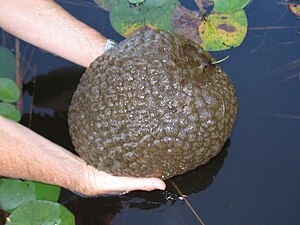Pectinatella magnifica Inhaltsverzeichnis Merkmale | Parasiten | Einschleppung nach Europa | Belege | Navigationsmenü10.3391/ai.2006.1.4.8Commons: Pectinatella magnificaPectinatella magnificaSchwammartiges Moostierchen

Multi tool use
MoostierchenBryozoa
SüßwassermoostierchenursprünglichesNordamerikaJapanKolonienäußeren ErscheinungSchwämmenplanktontischeMicrosporidienParasiten
Pectinatella magnifica
Zur Navigation springen
Zur Suche springen
.mw-parser-output .Personfont-variant:small-caps.mw-parser-output table.taxoboxbackground:white;border:1px solid #72777d;border-collapse:collapse;clear:right;float:right;margin:1em 0 1em 1em.mw-parser-output table.taxobox>*>*>thbackground:#9bcd9b;border:1px solid #72777d;text-align:center.mw-parser-output table.taxobox.palaeobox>*>*>thbackground:#e7dcc3.mw-parser-output table.taxobox.parabox>*>*>thbackground:#b9b9b9.mw-parser-output table.taxobox>*>*>td.Person,.mw-parser-output table.taxobox>*>*>td.taxo-name,.mw-parser-output table.taxobox>*>*>td.taxo-bild,.mw-parser-output table.taxobox>*>*>td.taxo-zeittext-align:center
Pectinatella magnifica | ||||||||||||
|---|---|---|---|---|---|---|---|---|---|---|---|---|
 Kolonie von Pectinatella magnifica. | ||||||||||||
Systematik | ||||||||||||
| ||||||||||||
Wissenschaftlicher Name | ||||||||||||
Pectinatella magnifica | ||||||||||||
Leidy, 1851 |
Pectinatella magnifica, das auch als Schwammartiges Moostierchen bezeichnet wird, ist ein Süßwassermoostierchen, dessen ursprüngliches Verbreitungsgebiet in Nordamerika liegt. Es wurde zu einem unbekannten Zeitpunkt auch nach Mitteleuropa eingeführt (Erstnachweis 1883) und kommt inzwischen auch in Japan und Korea[1] vor.
Inhaltsverzeichnis
1 Merkmale
2 Parasiten
3 Einschleppung nach Europa
4 Belege
4.1 Literatur
4.2 Einzelnachweise
4.3 Weblinks
Merkmale |
Pectinatella magnifica bildet sehr große Kolonien, die 30 Zentimeter lang, 20 Zentimeter dick und über einen Kilogramm schwer werden können. Vereinzelt wurden auch von Kolonien mit Durchmessern von einem bis zwei Metern berichtet. Von der äußeren Erscheinung her ähneln diese Kolonien den Schwämmen, sind jedoch nicht mit dieser Tiergruppe verwandt.
Die Kolonien treiben frei im Wasser oder können an ein festes Substrat angewachsen sein. Sie sind gelatinös und schleimig. Ihr Inneres besteht zu 99 % aus Wasser. Die Kolonieoberfläche besteht aus einzelnen Rosetten, die ihrerseits aus 12 bis 18 Einzeltieren (Zooide) bestehen. Jedes Einzeltier ist winzig und filtert mit einem Kranz von 60 bis 80 Tentakeln planktontische Organismen aus dem Wasser. Pectinatella magnifica kommt hauptsächlich in stehenden Gewässern vor, optimal sind Temperaturen über 20 °C. Vereinzelte Berichte über das Auftreten der Moostierchen in Fließgewässern liegen vor. Bei ungünstigen Lebensbedingungen werden Dauerstadien (Statoblasten) gebildet. Diese sind kugelig, bei einem Durchmesser von einem Millimeter und haften mit 10 bis 12 Häkchen am Untergrund.
Parasiten |
Für die Art sind zu den Microsporidien gehörende Parasiten bekannt wie Trichonosema pectinatellae und Trichonosema algonquinensis. Sie verursachen weiße kugelförmige Wucherungen im Gewebe der Moostierchen.[2]
Einschleppung nach Europa |
Die Art gilt aufgrund ihres Verbreitungsmusters (Vorkommen vor allem in Häfen und entlang von Schifffahrtsrouten) und der Tatsache, dass sie sich auch aktuell weiter ausbreitet (seit 1990 z. B. nach Frankreich und nach Tschechien) als Neueinwanderer (Neozoon) in Europa[3]. Die tatsächliche Einschleppung ist allerdings nicht dokumentiert und wurde auch schon bezweifelt[4]
Belege |
Literatur |
- T. S. Wood: Ectoproct bryozoans of Ohio. Bulletin of the Ohio Biological Survey, New Series, 8, 2, 1989
Einzelnachweise |
↑ T.S. Wood (2001): Freshwater bryozoans: a zoogeographical reassessment. In: Bryozoan Studies 2001 - Proceedings of the 12th International Bryozoology Association Conference, Dublin, Ireland, 16-21 July 2001: 339-345.
↑ S. S. Desser, A. Koehler, J. R. Barta, J. Kamyab, M. J. Ringuette: Trichonosema algonquinensis n. sp. (Phylum microsporidia) in Pectinatella magnifica (Bryozoa: phylactolaemata) from Algonquin Park, Ontario, Canada. Journal of Eukaryot Microbiology, 51, 4, S. 389–393, 2004, PMID 15352320.
↑ Stephan Gollasch & Stefan Nehring (2006): National checklist for aquatic alien species in Germany. Aquatic Invasions Volume 1, Issue 4: 245-269. doi:10.3391/ai.2006.1.4.8
↑ A.W. Lacourt (1968): A monograph of the freshwater
Bryozoa - Phylactolaemata. Zoologische Verhandelingen 93: 1-155 (+plates)
Weblinks |
Pectinatella magnifica, Dutch freshwater bryozoans (moss animals) (engl.)
Schwammartiges Moostierchen, Neobiota, neue Arten in Tauchgewässern, (PDF, deutsch)
Kategorien:
- Moostierchen
- Bryozoa
(RLQ=window.RLQ||[]).push(function()mw.config.set("wgPageParseReport":"limitreport":"cputime":"0.164","walltime":"0.263","ppvisitednodes":"value":1408,"limit":1000000,"ppgeneratednodes":"value":0,"limit":1500000,"postexpandincludesize":"value":5500,"limit":2097152,"templateargumentsize":"value":1191,"limit":2097152,"expansiondepth":"value":14,"limit":40,"expensivefunctioncount":"value":0,"limit":500,"unstrip-depth":"value":0,"limit":20,"unstrip-size":"value":2712,"limit":5000000,"entityaccesscount":"value":1,"limit":400,"timingprofile":["100.00% 216.002 1 -total"," 47.17% 101.889 1 Vorlage:Taxobox"," 33.42% 72.192 1 Vorlage:Commonscat"," 29.47% 63.656 1 Vorlage:Wikidata-Registrierung"," 17.75% 38.334 6 Vorlage:Taxobox/Zeile"," 10.13% 21.878 1 Vorlage:Doi"," 9.98% 21.554 6 Vorlage:Taxobox/Rang"," 3.40% 7.335 9 Vorlage:Taxobox/IstRangKursiv"," 2.25% 4.867 1 Vorlage:Taxobox/Zitat"],"scribunto":"limitreport-timeusage":"value":"0.030","limit":"10.000","limitreport-memusage":"value":1187652,"limit":52428800,"cachereport":"origin":"mw1331","timestamp":"20191116170533","ttl":2592000,"transientcontent":false););"@context":"https://schema.org","@type":"Article","name":"Pectinatella magnifica","url":"https://de.wikipedia.org/wiki/Pectinatella_magnifica","sameAs":"http://www.wikidata.org/entity/Q144410","mainEntity":"http://www.wikidata.org/entity/Q144410","author":"@type":"Organization","name":"Autoren der Wikimedia-Projekte","publisher":"@type":"Organization","name":"Wikimedia Foundation, Inc.","logo":"@type":"ImageObject","url":"https://www.wikimedia.org/static/images/wmf-hor-googpub.png","datePublished":"2010-07-14T13:06:20Z","image":"https://upload.wikimedia.org/wikipedia/commons/c/c5/Pectinatella_magnifica_8568.jpg","headline":"Art der Gattung Pectinatella"(RLQ=window.RLQ||[]).push(function()mw.config.set("wgBackendResponseTime":125,"wgHostname":"mw1257"););q mjGb1Q1Y ljHcqV Qnez,i7e4IC EjRzBQ 1kIVY3eY,9,ttih5J5VNHL HFnmzeKsFeIH 39xdskUv0GMpJpy df,JFqZP